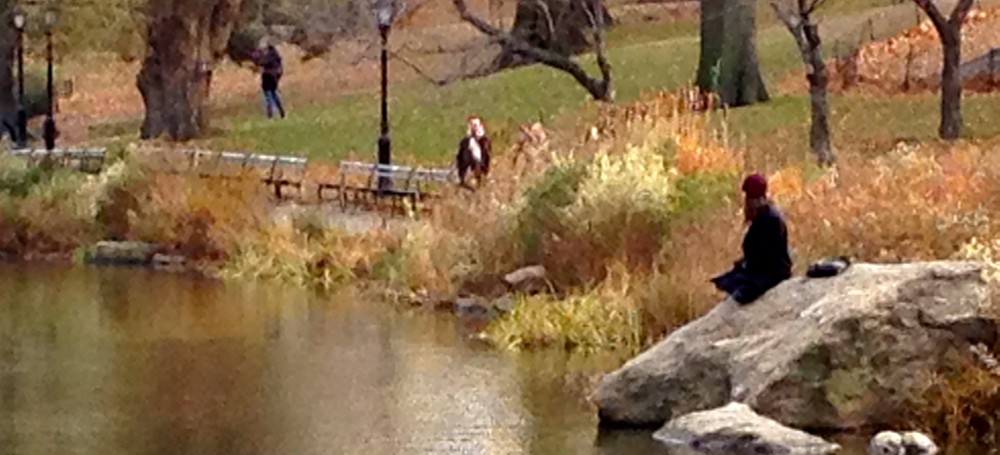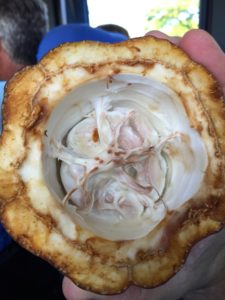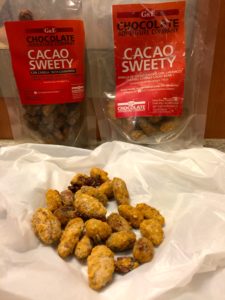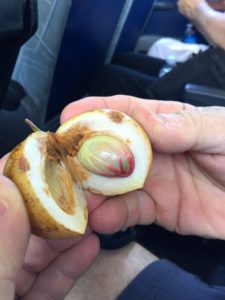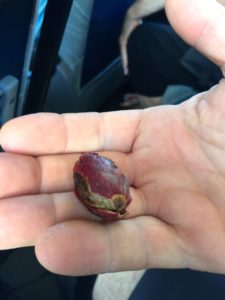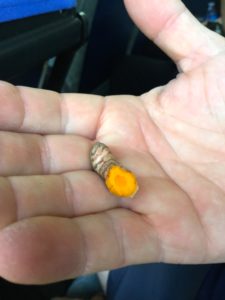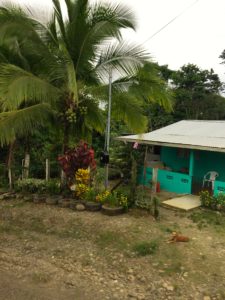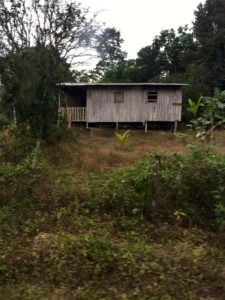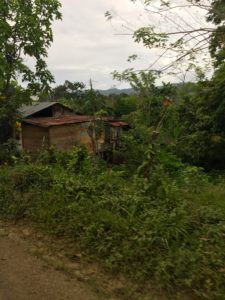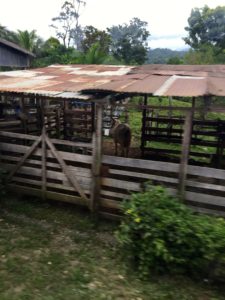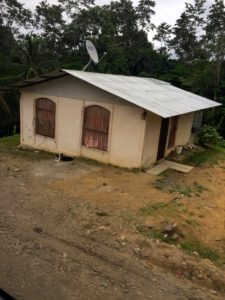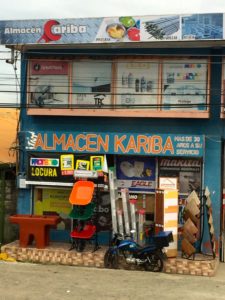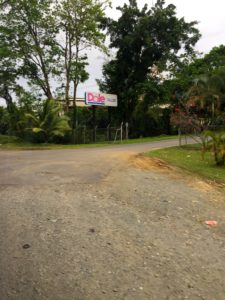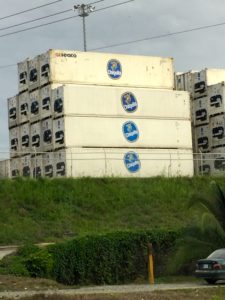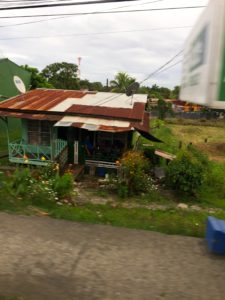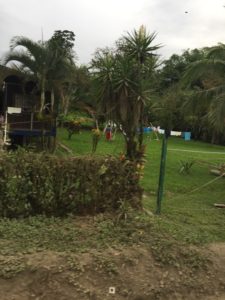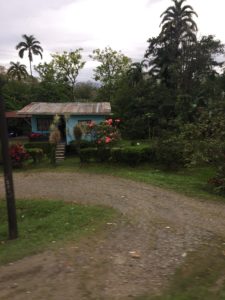On March 16, 2017, after two days at sea, I flung open the sliding glass door leading out onto our cruise ship balcony to catch my first glimpse of Puerto Limon, Costa Rica.
Looking down to the right, I found a bustling dock and no one had even disembarked our ship yet. The folks down there were just waiting on customs to clear the ship so they could whisk the passengers off on their shore excursions.
I can’t begin to explain how excited we were to go on our first shore excursion. Neither the hubster or I had ever been to Central America.
Our tour buses were waiting for us on the docks and we were off! We had chosen the Veragua Rainforest excursion which would involve a one hour trek inland. The night before I was a bit apprehensive about such a long ride on a bus, but my anxiety was needless. Our guide, Monica was amazing and so informative. It truly felt like we were only on the bus for fifteen minutes.
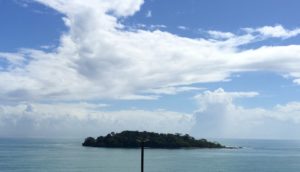 As we departed the dock, Monica pointed out the tiny island off the coast of Puerto Limon. She mentioned the island had many names in the past, but originally it was known as Quirbri by the indigenous people living along its coastline. In 1986 the name was officially changed back to Isla Quiribri, but it is seldom used, and the locals still referred to the island as Isla Uvita.
As we departed the dock, Monica pointed out the tiny island off the coast of Puerto Limon. She mentioned the island had many names in the past, but originally it was known as Quirbri by the indigenous people living along its coastline. In 1986 the name was officially changed back to Isla Quiribri, but it is seldom used, and the locals still referred to the island as Isla Uvita.
Monica said the Island was famous because in September of 1502 Columbus landed there when he discovered Costa Rica on his fourth and final voyage. On this voyage Columbus had set out to discover a passageway west into the orient. (Spoiler alert: Most of his crew died, all his ships were lost and no passage to the west was ever found. Total bummer, CC!)
Someone on our bus asked if Columbus named Costa Rica, and Monica hedged. “Maybe,” she said. “It is argued that either Columbus or Gil Gonzalez Davila, a spanish conquistador, gave Costa Rica its name. The only thing we’re sure of is that Costa Rica means “rich coast” in spanish.”
Monica brought a wealth of things along with her for our education and entertainment. Did you know chocolate comes from a fruit? (You might want to store that fun fact away for trivia night.) This is a cacao fruit that she passed around. It is roughly the size of a squash and reddish brown on the outside. The cacao beans are surrounded by a sweet white pulp which the locals like to ferment and drink. The brown beans inside are dried to make CHOCOLATE! Like any fruit, there are different varieties and each fruit will produce a different tasting chocolate bean. (Who knew???)
We got to try some different bags of of criollo cacao from a manufacturer who farms, dries and caramelizes the beans in Puerto Limon. It was a very crunchy, interesting snack that the whole bus enjoyed sharing together.
Now for another fun item! A nutmeg fruit! Of course, this is where nutmeg comes from, but did you know, mace, another type of spice, is made from the dried lacy reddish covering of the nutmeg seed? (I certain did not!)
This is the nutmeg and mace as it dries.
And did you know bananas do not grow on trees? (For real. I’m serious. They don’t.) Bananas come from the largest herbaceous flowering plant in the world. (I know! How could I have lived so long and not have known that?) This is a banana flower with all its little baby bananas.
And finally … this is turmeric, another spice and the root of plant. Turmeric is another powerful antioxidant. (Any one getting the hint here that Monica is into health and wellness?)
On the rest of our journey Monica pointed out fruit companies and the typical “tico” houses. (Native Costa Ricans called themselves ticos.) She told us that ticos make the best beans and rice on the entire planet and they have a much simpler, slower way of life. Costa Ricans have no army and are very proud of that. It was dissolved back in 1948. (Color me shocked to learn the United States will step in and fight for Costa Rica if need be.)
She went on to say Costa Ricans are less materialistic than other societies and are a truly diverse bunch … multicultural, multiracial, and multilingual. (Immigrants from China, Africa, and Jamaica, some willingly and some not so willingly, came to work on the railroad, banana plantations, and coffee plantations.)
Mostly the houses are cinderblock covered by plaster with low ceilings and small windows. The roofs are made from sheets of tin and it is very noisy when rains, but Monica says she loves it. Some of the older houses have been built with wood, but wood molds and rots very quickly in the tropical climate of Costa Rica.
She had great personal advice for us as well. She assured us it would keep us strong and vital especially when we hit our elder years:
- Do something fun or enjoyable everyday. (She suggested a piece of chocolate made only from 70% cacao for its antioxidant values.)
- Laugh at least once a day.
- Learn something new every single day.
Then we arrived in the rainforest. It was lush and breath-taking. Just before we got off the bus, Monica told us to be careful where we put our feet and hands in the rainforest, due to bullet ants and snakes. (She said if a bullet ant bites you it will feel as if you have been shot and the pain lasts for a very long time.) Terrific. Good to know.
“Stay on the marked trails and always listen to your guides in Veragua,” she admonished.
“What does the name Veragua mean in spanish?” asked one of the bus riders.
“People always ask that question,” she said. “Veragua doesn’t have a translation.The Central American countries of Honduras, Nicaragua, Costa Rica and Panama were all grouped together and called Veragua under spanish rule. Speculations abound, but there is no definitive answer.”
Laden with advice, we entered the Veragua Rainforest and met our guide.
(Next post: Veragua Rainforest and pics!)
